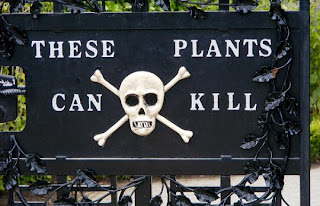I've always been interested in wild plants, both edible and poisonous, because I like the thought that I'd be okay surviving in the wilderness for a while (shout-out to Hunger Games fans!). So it was pretty easy for me to memorize which plants affect horses, and what they look like. For non-plant-geeks, however, it's a chore. Library books and online guides are great, and Equus magazine has a nice feature this month, but these resources often have problems, like:
- They show plants in only one stage of growth, making them harder to identify.
- Sometimes they don't even show a picture of the plant.
- They don't list plants that, while not poisonous, are of interest to horse people-- for example, the catnip your barn kitties would love.
- They throw all the plants at you at once, rather than breaking them down by season or region. Ex: locoweed is very very rare in the north, and unless a starving horse wanders into a garden filled to the brim with foxglove, it's highly unlikely that it will pose any danger.
- That crap is boring. Scientific names? Method of propagation? *Snore*
Stinging Nettles
Ouchy! Not poisonous, but can cause major skin rash on people and horses (though some horses seem less affected, and will even nibble young ones). Super common in pastures, or on fence lines, they'll take over an area if you let them. The leaves are arranged like a plus sign. The stalks are purplish. In the spring, they're fairly short, but will grow a lot taller. The "toothy" edges of the leaves are spiky, not rounded. You can soak 'em in water to make them edible, and they're super nutritious-- European peasants often survived on them in tough times. Here's a brief recipe for nettle soup. Some people have actually been able to sell these at farmers markets! Hmmm, I wonder if I could sell "organic fertilizer" to the local yuppies...
Catnip
Useful, not poisonous. Catnip looks a lot like stinging nettles; same "plus" shape, same leaf type. But the "toothy" edges are rounded, the stems are not purplish, and the whole plant has a slightly fuzzy look to it. Plus, the moment you step on catnip, it smells very strongly of... well, catnip. Catnip tea is supposedly soothing. If you have the patience to distill the oils of the plant (by steaming), it's a great natural bug repellent. And of course, your barn kitties will love both fresh and dried catnip (tie a bunch with twine and hang it up in your barn or garage to dry it). Just be sure to have plenty of Fancy Feast on hand when they get the munchies.
Burdock
Annoying, but not poisonous. This is the stuff that eventually spawns those awful prickly balls that stick to your horse, saddle blanket, dog, clothes, and everything else. They actually inspired the invention of velcro. The plant starts small and innocent, with tough, wide leaves that grow in clusters from the ground. They get big fast. Kill 'em now before they spread! You can dig up the roots, soak them, and then eat them raw like carrots, blanched in a stir fry, or fried like french fries. Except, much more bland and woody.
Hemlock
Okay, that's all for now! Pretty painless, right? The early summer edition will show you a couple of these plants as they develop, and I'll add in a few, like nightshade, that haven't really sprouted yet. Before I go, though, I can't resist a little...
Hunger Games Trivia
Real World Rough Equivalents:
Katniss = Arrowhead plant, and edible aquatic creeper with potato-like roots
Groosling = Grouse?
Tracker Jackers = notoriously aggressive yellowjackets?
Nightlock = nightshade, but more instantly deadly
Is Peeta a pun on pita bread?
Mockingjays are of course mockingbirds + bluejays...click here to hear a mockingbird imitate a car alarm, a crow, a seagull and other sounds.
The rue flower.





